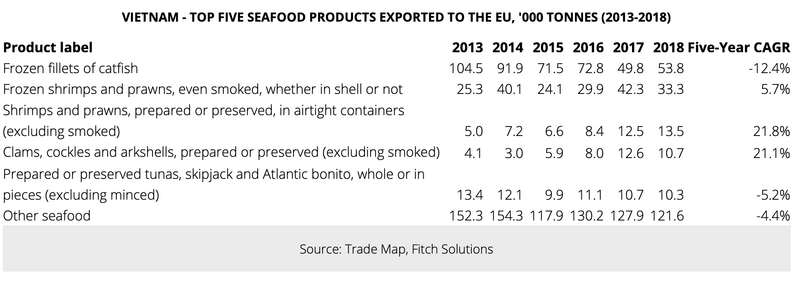Vietnam seafood perfectly well placed to benefit from EVFTA
The fact that Vietnam is already a top trade partner with the EU despite not having an FTA in place highlights the opportunities that the EVFTA will create for Vietnamese seafood producers.
As the EU – Vietnam Free Trade Agreement (EVFTA) has come into effect, Vietnamese seafood exports are perfectly placed to take advantage of improved market access with the EU, according to Fitch Solutions, a subsidiary of Fitch Group.
Out of the total seafood products Vietnam exported in 2019 at US$7.8 billion, approximately 13.5% went to the EU. With the ratification of the EVFTA, Vietnamese seafood will see improved market access via either duty-free tariff rate quotas or the full liberalization of tariff structures, stated Fitch Solutions.
The EU Is A Key Export Market For Vietnamese Seafood Vietnam - Top Five Export Partners For Seafood Exports, USDmn (2009-2018) |
In 2018, the EU was Vietnam's third largest export market for seafood products, at US$1.2 billion (or 13.3% of total seafood exports). Only the US (US$1.6 billion) and Japan (US$1.4 billion) import more seafood from Vietnam. Following the FTA, Fitch Solutions highlighted that there is potential to increase the EU’s share within Vietnam’s total seafood exports over the coming years.
Vietnam is main seafood trade partner for the EU
From the EU's perspective, Vietnam is the region's fourth largest non-EU country for seafood imports in 2019, after China, Ecuador and Morocco. Over the past 10 years, the EU has imported a relatively similar amount of Vietnamese seafood per year, but its ranking has fallen from the second largest import market in 2010. Ecuador joined the EU-Colombia/Peru trade agreement in 2016, which saw the elimination of all tariffs on fishery products.
Similarly, Morocco has an Association Agreement with the EU, which gives preferential treatment for agricultural, processed agricultural and fishery products. This highlights how FTAs have been utilized by countries to successfully increase the amount of fish products exported to the EU.
The fact that Vietnam is already a top trade partner with the EU despite not having an FTA in place, highlights the opportunities that preferential treatment and trade liberalization will create for Vietnamese seafood producers.
Shrimps, prawns and catfish are Vietnam’s leading export products to EU
Breaking down the seafood products Vietnam currently exports to the EU, the top value products in 2018 are shrimps, prawns and frozen catfish fillets, which collectively account for US$700 million (or 60.9%) of the total US$1.2 billion worth of seafood exported to the EU in 2018.
Shrimp farming is one of the biggest agricultural industries in Vietnam, and the government is pushing to expand it, having announced plans in 2017 to boost exports from US$3 billion in 2016 to US$10 billion by 2025.
EU consumers demanding more seafood products
European consumers have increasingly been spending more on fish and fish products. in 2020, the average European household will spend an average of US$271 on seafood products through the mass grocery retail channel. Fitch Solutions forecast this growing at a compounded annual growth rate (CAGR) of 4.1%, out to 2024, where spending on seafood reach US$331. While the EU does have a significantly large fishery industry, there are certain seafood products that are in high demand, but must be sourced outside of the region. As such, the import of seafood products by the EU has grown by an average of 2.3% a year, in value terms, and 1.9% a year, in quantity terms.
Preferential access unlocks significant opportunities for Vietnamese producers
Taking the above into account, as well as the details of the FTA, Fitch Solutions noted two Vietnamese seafood products will benefit from increased trade over the next few years:
Shrimp and prawns. It is expected that non-processed shrimp will benefit the most, out of any Vietnamese seafood product, from increased trade between the EU and Vietnam. As mentioned, non-processed shrimp will see its tariff structure be completely liberalized from ratification date (July 2020), meaning that Vietnamese shrimp will immediately be more price competitive. In 2019, Ecuador, Argentina and India all exported more shrimp than Vietnam. Neither Argentina nor India have an FTA with the EU, meaning Vietnam will quickly be able to capitalize and increase its share of the EU market.
Canned, fresh and chilled tuna. The trade agreement will give immediate duty-free tariff rates to 11,500 tones of canned, fresh and chilled tuna. Vietnam exported 26,700tonnes of tuna products to the EU in 2018. While strict rules of origin will apply here, just over 40% of Vietnamese tuna exports to the EU will be tariff free. Vietnamese producers can then average out the lower cost onto its other products, resulting in a better price margin.














